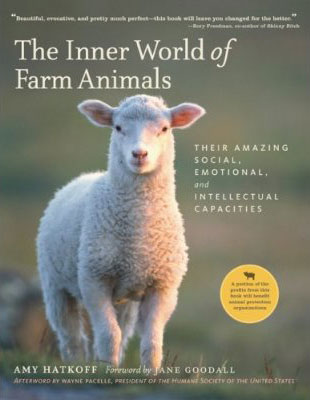Book Review: The Inner World of Farm Animals
Their Amazing Social, Emotional, and Intellectual Capacities
By Amy Hatkoff
Published by Stewart, Tabori & Chang, 2009
www.amyhatkoff.com www.stcbooks.com
Review by Karen Davis, PhD, President of United Poultry Concerns
I looked at the piece of animal on my plate, and it symbolized fear, pain, and death. I stopped eating it - Jane Goodall, Foreword

The Inner World of Farm Animals is dedicated “to farm animals everywhere and to all those who are standing by, with, and for them.” The book combines beautiful color photographs with stories and perspectives by sanctuary directors and animal scientists showing that chickens, turkeys, ducks, geese, cows, sheep, pigs, and goats possess complex emotions, intelligence, consciousness, and social skills. Like us, these animals are sentient beings. Sentience, Hatkoff explains, “means being aware of oneself, one’s surroundings, one’s bodily sensations, and of the emotions corresponding to that awareness. It means having an awareness of other animals as well as of humans. Research shows that farm animals have a wide range of feelings, including loyalty, sadness, joy, and fear” (p. 17).
Stories illustrating these claims begin with an account of a mother duck who quacked and tugged beseechingly at the pant leg of a police officer to get him to accompany her to a sewer grate where he discovered that her eight ducklings had fallen through the grates. The ducklings were promptly rescued and reunited with their mother. The point of the story is that the mother duck’s actions on behalf of her youngsters showed conscious intention, determination, parental devotion, and distress, the same as would be found in a human mother.
The sad irony of the story is that the vast majority of farmed animals are stuck, without any hope of being rescued, in the sewer. No police officer will ever pull them out of it and no caring mothers will hear their cries, let alone be in a position to help them. Rescued farmed animals represent the lucky few - comparable to a teaspoon of ocean water - who chanced to find comfort and joy in the friendship and loving companionship of other animals in a sanctuary, in the care of compassionate people. Their stories along with the photographs are the heart and soul of this book.
The scientific contribution focuses mainly on experiments in which chickens and other animals are praised by researchers for proving they’re smart enough to learn which levers and computer keys to press in order to get food or some other so-called reward. Are you surprised to learn that chickens will peck keys 100 times to reach a place where they can dustbathe but only 10 times to reach a place full of thumbtacks? Marion Stamp Dawkins, who designed this experiment, also “discovered” that the hens in her laboratory will work harder to get back to their chicks, when experimentally separated from them, than they will to get back to their adult flockmates (p. 37). Granting this, one wonders what application it could have to chicken farming, in which breeding flocks and hatcheries are totally separate operations.
In this generally lovely and illuminating book, to which I was pleased to contribute, I wish that the author had shunned the pseudoscience that ranks animals according to who is “smarter” than whom. At best, it’s plain silly. And I wish the book had not included Matthew Scully’s fusty declaration about animals in Dominion that “We are called to treat them with kindness, not because they have rights or power or some claim to equality, but because they don’t.”
If a purpose of The Inner World of Farm Animals is to teach people to respect farmed animals instead of patronizing and demeaning them, the Scully quotation doesn’t fit. Nor does suggesting that people like Wolfgang Puck, who cook animals and make money off their misery while spouting rubbish about being against “factory farming,” are benefactors of farmed animals. Fortunately, while mentioning welfare measures that are being taken to help animals raised for food, Hatkoff does not overstate their effectiveness.
The Inner World of Farm Animals, with its beautiful images and moving personal stories, should be placed in locations where ordinary people can easily pick it up, browse and be affected by the beauty, plight, and fellowship of farmed animals and want to help them. It is a thoughtful holiday gift that includes a list of advocacy organizations and sanctuaries to contact for more information. - Karen Davis, United Poultry Concerns
|